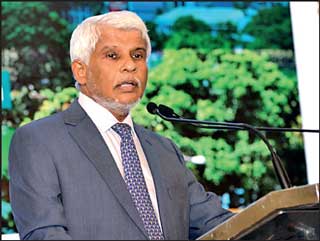Sunday Oct 26, 2025
Sunday Oct 26, 2025
Wednesday, 14 December 2022 00:00 - - {{hitsCtrl.values.hits}}

Representatives from EU, UNIDO, relevant ministries, and the panelists at the Industry Dialogue on Challenges and Opportunities of the Current Energy Crisis organised by the EU-funded AICRSL project
 |
| EU Ambassador to Sri Lanka and the Maldives Denis Chaibi addressing the audience |
 |
| Minister of Environment Naseer Ahamed delivering his opening remarks
|
Leaders from across the industry, civil society, finance and academia met in Colombo earlier today to explore short and long-term energy solutions amidst Sri Lanka’s worst-ever energy crisis.
With Sri Lanka’s industrial sector among the largest consumers of costly imported fossil-fuels, more than 100 participants heard from experts and shared their insights into how this economically important sector can move towards more sustainable energy use.
“By decoupling Sri Lanka’s industrial development from the use of imported fossil fuels, we can avoid energy crises in the future and help slow down global climate change,” said the Minister for the Environment Naseer Ahamed during his opening remarks.
The Minister for Industries, Dr. Ramesh Pathirana, stated that: “The industrial sector employs 30% of the national workforce, so it’s essential that we future-proof this sector”.
Organised by the European Union (EU)-Funded “Accelerating Industries’ Climate Response in Sri Lanka” (AICRSL) project, the event’s centre-piece was a panel discussion between leading energy experts and innovators.
With expertise in leveraging finance, new technologies, and international trade in a changing world, the panellists shared some of the latest developments in the area of sustainable industrial energy.
Speaking at the event, EU Ambassador to Sri Lanka and the Maldives H.E. Denis Chaibi stated: “As global markets demand products with lower carbon footprints, we are eager to help Sri Lanka reap economic benefits by tapping into niche markets that seek sustainably produced goods, while also acting on climate change. This is part of the external dimension of the EU’s Green Deal, our blueprint for securing a sustainable energy future.”
Meanwhile, a showcase of Sri Lankan Energy Savers, people in industry and government who are already helping improve energy use, was on display at an in-event exhibition. Those attending were invited to nominate other Energy Savers whose efforts should be recognised – and could inspire others to take action.
“Every transformational story needs people who will take on a challenge, run with it and make change happen. Sri Lanka’s Energy Savers are exactly that: courageous industry leaders and energy practitioners determined to help the country slash industries’ energy waste and greenhouse gas emissions. I look forward to seeing more Energy Savers emerge as the initiative progresses,” said United Nations Industrial Development Organisations (UNIDO) Project Manager Nicholas Dehod.
The event is the first in a series of industry dialogues planned by the AICRSL project, a Rs. 2.8 billion (€7.56-million) partnership between the Sri Lankan Government, the EU and UNIDO. This effort is designed to help the country’s industrial sector cut its greenhouse gas emissions (GHG) by 7% by 2030. The initiative will achieve this aim by supporting industry to use more renewable energy, such as solar PV and biogas, and improve energy efficiency.
The five-year initiative will work across a wide-range of areas, including measurement, reporting and verification of GHG emissions and creating policies to support industries to move to low-carbon technologies.
Hundreds of industry managers and service providers will gain expertise on renewables and energy efficiency, and funding opportunities will be unlocked to increase low-carbon technology investments. Industry dialogues and other events will be held throughout the initiative to enable the government, the business community, the finance sector and civil society to share the technical knowledge, insights and solutions needed for a low-carbon future.